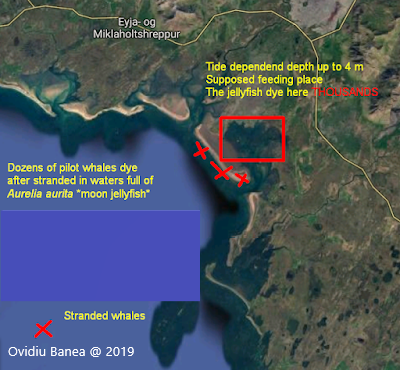The latest Globicephala sp.
22.07.2019
Reykjavik
by Ovidiu C. Banea
After we came yesterday from the region of Gamlæryi where we met Jóhannes, a farmer on his tractor, and had the amiability to tell us about the region and the risks to visit it, journalists arrived today in the area of Gamlæryi and they did more than 50 pictures to the place and to the dead carcasses. They used special car and tracks to arrive there.
We hope soon specialists form Icelandic marine biology institutions or veterinarians with police will visit the area to protect the site for visitors and avoid other unpleasant situations of infections, epidemics or other parasites distribution.
Icelandic representative of Crispus NGO Sibiu Romania will try to install 3 cameras with infrared far from the site to analyse the behavior of the land predator arctic fox in the region.
The reasons of why the whales stranded is not well known yet and it is difficult to make affirmations. Probably a mixture of reasons produced the whales to be stranded. In our opinion the food abundance and the clear waters might represent a good place for the whales to beach. It is now more evident from the video recorded on the 40 whales stranded on 16th of July 2019 in Sant Simons Island, Georgia that whales are going together and help the injured one or the one which might have a difficult delivery. On 18th of July 2019 Berglind Árnardóttir recorded a video of a pilot whale during 2 hours on the tide-in moments and shared it with us. It was clear that the whale was approaching the shore. Why is that, remains a mistery. The whales are beaching for centuries here, in Faroe Islands and even we dislike totally the Persistent organic pollutants (POPs) in the sea waters we cannot blame humans as being the anthropogenic factor of these 53 whales death until there is no pertinent analyses of their stomach content. Other condition might be the magnet of the brain the whale capacity to follow the routes in the sea using their magnetite or their geomagnetism sense. If this got lost then yes, there it might be another reason. But why to be lost? Military exercise, less likely to have an exercise here and another one at 8.000 km far. Or in different years to have the whale in search for the beach in November last austral summer in New Zealand and now boreal summer here. The climate change, might be, but not the human factor it and the print of industrialization because this happened for centuries.
So, Gamlæryi is a tide dependent wetland is a new mini delta and is plenty of food and wellness. The whales want to beach in Georgia or here, but yes without having into account a tide of 4 meters which in calm conditions you do not feel it. They just loose their energy to run from the front of water.
Nature is nature, the mammals arrived to the shore for food for Aurelia aurita, we saw hundreds and thousands of them dead or dying on the shore of Gamlæry lake. Or they came to help a injured whale of the group or they came to the beach because they lost the way due to the biomagnetism lost capacity due to a submarine volcanic eruption, the reason they come to the shore could be important and nice to study but the reason they died is obvious. The low tide or the social bond and solidarity with the victim. I still prefer the first since we do not have evidences on their consciousness.
A larger multi-region studies and an urgent contact between researchers from New Zealand, Norway, Iceland and United States where exists evidence of these losses in the last 6 years is needed to assess and understand all ecological factors and analyze them before claiming people as the main problem or before claiming the whale of eating our fish, because those are not so good in that. Crispus NGO Sibiu Romania and Romanian Icelandic NGO Iceland are ready to collaborate with other NGOs or even with the Icelandic Institute of Natural History (IINH) to have knowledge in this type of issues and be invited to first aid needed in such cases to avoid these events.
Gamlæryi maritime levee
Aurelia aurita in Southern Snæfelsness Penisnula. On 20th of July we observed more than 500-1000 exemplars on the shore and the bottom of the empty lake. We arrived there when the die was at lowest level. Ingvar H. Ólafsson told us and send us the levels on same day. We found that Aurelia aurita is living also at depths up to 500-1200 m where pilot whale only when I looked at home at the species.
We support ecotourism and the facilities who will follow green policies in the region as Hótel Búðir who had the desire to share with us the videos recorded on same day at the reported news, on 18th of July 2019. We hope that, the lonely pilot whale is still alive and that she will appear some day with the newborn and we can help them to go back into the water.










Niciun comentariu:
Trimiteți un comentariu